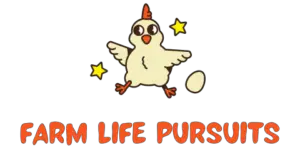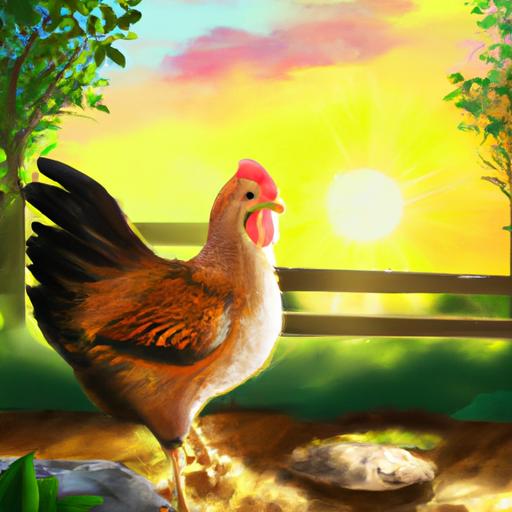Do you know how a chicken’s crop works? This ultimate guide will unravel the mysteries of the crop and provide you with an in-depth look at its purpose and function.
From the location of the crop to the role of enzymes, you will gain a wealth of knowledge about this organ.
We will also discuss how the crop can expand, how to empty it, and the benefits of understanding it.
Finally, we’ll provide crop health tips for farmers and pet owners.
Let’s get started!
Table of Contents
Short Answer
A chicken’s crop is an expansion of the esophagus located near the base of the neck.
It is a muscular pouch that stores food before it enters the digestive tract.
The crop relaxes when the chicken eats, allowing food to pass from the mouth to the crop.
The food then passes slowly into the digestive tract where it can be digested and absorbed.
The crop also produces a natural form of antibiotics to help fight off bacteria and other infections.
Location of the Crop
A chicken’s crop is an organ located at the base of the chicken’s neck, just below the beak.
It is an important part of the digestive system and its primary function is to store food before it is digested.
The crop is a muscular pouch that can expand to accommodate more food and can be emptied when necessary.
The crop helps to regulate the rate at which food is digested and also softens the food with digestive enzymes before it passes into the stomach for further digestion.
The location of the crop is important because it is easily accessible to both pet owners and farmers.
Pet owners can easily check the crop to make sure it is not overfull or too empty.
Farmers can also check the crop to ensure that the chickens are getting enough food and that their digestive system is functioning properly.
The crop is also important for chickens because it helps to regulate their eating habits.
Chickens are known to overeat, so having the crop helps to control how much food they consume at once.
It also helps to keep the food in the crop for longer periods of time, which allows the digestive enzymes to soften it before it passes into the stomach.
This helps to ensure that the food is properly digested and that the chicken is getting all of the nutrients they need.
What the Crop Does

The crop is an important organ in the digestive system of chickens, located at the base of their neck.
Its primary function is to store food until it is softened by digestive enzymes.
Once the food is softened, it can be broken down further in the stomach.
This process helps regulate the rate of digestion, allowing the chicken to properly process its food.
The crop also has the ability to expand, allowing it to store more food when necessary.
When the crop is full, it can be emptied by regurgitating the food back up into the mouth.
This is also known as crop milk and is used by mother chickens to feed their chicks.
By understanding how a chickens crop works, farmers and pet owners can provide better care for their chickens.
For example, they can ensure that the crop is not overfilled and that the food is softened before it is digested.
This can help prevent crop impaction, where food becomes stuck in the crop and prevents proper digestion.
Additionally, farmers and pet owners can provide their chickens with the right type of food, such as a high-quality feed, to ensure their chickens are getting the nutrition they need.
The Role of Enzymes in the Crop
When a chicken eats food, it is first stored in the crop.
This muscular pouch is located at the base of the chickens neck and is an important part of the digestive system.
In order for the food to be digested further in the stomach, it must first be softened by digestive enzymes.
The enzymes secreted by the crop are essential for the breakdown of food particles, as well as for the regulation of the rate of digestion.
These enzymes are released when the crop is full and the food is ready to be moved into the stomach.
The enzymes help to break down proteins, convert starches into simple sugars, and break down fats into fatty acids.
In addition, they also help to reduce the pH level of the food, making it more acidic and allowing for easier absorption in the stomach.
The enzymes in the crop are also important for regulating the rate of digestion.
Without them, food would move too quickly through the digestive system, making it difficult for the chicken to extract all the nutrients they need.
The enzymes help to slow down the digestion process, allowing the chicken to absorb more of the nutrients.
By understanding how a chickens crop works, farmers and pet owners can better support the health and well-being of their chickens.
By providing them with a balanced diet and making sure they have access to plenty of fresh water, they can ensure that their chickens crops are functioning efficiently.
This, in turn, will help to keep the chickens healthy and happy.
How the Crop Can Expand

A chicken’s crop has the ability to expand and accommodate more food, allowing them to consume larger meals.
This can be useful for farmers who want to fatten up their chickens before slaughter.
It also helps pet owners who want to feed their chickens larger portions.
When the crop is full, the muscles in the crop wall contract and push the food out, allowing it to be further broken down in the stomach.
This muscular action also helps regulate the rate at which the food is digested.
Through this process, the crop can empty itself of food as needed and quickly fill up again.
The crop can also expand and contract in response to the amount of food that is given to the chicken.
This means that farmers and pet owners can adjust the amount of food they give to their chickens based on their size, age, and activity level.
How to Empty the Crop
The crop of a chicken can be emptied by a process known as crop emptying.
This is an important process for maintaining the health of a chicken and should be done regularly.
It is especially important for chickens that have been overfed, as the crop can become overly full and cause discomfort.
Crop emptying is usually done by resting the chicken on its side and gently squeezing the crop until the food is released.
This can be done with a gentle massage of the crop area or with a specialized tool.
After the crop is emptied, the chicken should be given some time to rest before it is fed again.
Additionally, the amount of food given to the chicken should be closely monitored to ensure that the crop does not become overly full.
Benefits of Understanding the Crop

Understanding the crop can be beneficial to both chicken farmers and pet owners.
Knowing how the crop works can help support the health and well-being of chickens.
A chickens crop helps to regulate the rate at which food is digested, and it can expand to accommodate more food.
By being able to recognize signs of a healthy crop, farmers and pet owners can ensure that their chickens are receiving the right amount of food and are digesting it properly.
Additionally, understanding a chickens crop can help prevent certain health issues.
For example, if a chicken has food sitting in its crop for too long, it can lead to sour crop, which is an infection caused by bacteria in the crop.
By recognizing the signs of sour crop early, farmers and pet owners can take appropriate steps to help their chickens recover.
Finally, understanding the crop can help farmers and pet owners better identify and address any potential problems.
For example, if a chickens crop appears overly full or is not emptying properly, this could indicate a problem that needs to be addressed.
By having a better understanding of the crop, farmers and pet owners can more quickly identify and address any issues.
Crop Health Tips for Farmers and Pet Owners
As a farmer or pet owner, it is important to take the necessary steps to ensure the health of your chickens crops. Here are some tips to help you keep your chickens crops in tip-top shape:
Make sure the chickens are being fed a balanced diet.
A balanced diet will help ensure that your chickens are getting all the nutrients they need to stay healthy.
Make sure the chickens have access to clean water.
Water is essential for digestion and keeping the crop healthy.
Give the chickens plenty of space to move around.
This will help keep their crops from becoming too full and will allow them to empty their crops more easily.
Monitor the chickens for signs of distress.
If a chicken appears to be struggling to eat or is unable to empty its crop, this could be a sign of an underlying health issue and should be checked out by a veterinarian.
Check the crop for any signs of infection or inflammation.
If you notice any redness or swelling in the crop area, it could be a sign of infection and should be treated immediately.
If the crop becomes impacted, contact a veterinarian for treatment.
Impaction can occur if the chickens eat too much or if they ingest something that is too large for the crop to handle.
If the crop becomes impacted, the veterinarian may attempt to manually break up the impacted material.
If the crop becomes impacted and the material is too difficult to break up, the veterinarian may refer you to a specialist who can perform surgery to remove the impacted material.
By following these tips, you can help ensure the health and well-being of your chickens crops.
Final Thoughts
Understanding how a chicken’s crop works is essential for supporting the health and well-being of chickens.
Knowing where the crop is located, what it does, and how it can expand can help farmers and pet owners provide the best care for their chickens.
Additionally, being aware of the role of digestive enzymes and how to empty the crop can assist in the regulation of a chicken’s digestive rate.
With this ultimate guide, you are now equipped with the knowledge to ensure your chickens receive the best care!

